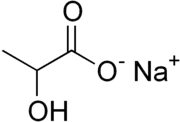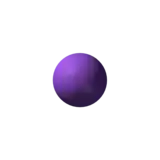Sodium lactate
Sodium lactate is the sodium salt of lactic acid, and has a mild saline taste. It is produced by fermentation of a sugar source, such as corn or beets, and then, by neutralizing the resulting lactic acid[4] to create a compound having the formula NaC3H5O3.
 | |||
| |||
| Names | |||
|---|---|---|---|
| Preferred IUPAC name
Sodium 2-hydroxypropanoate | |||
| Other names
Sodium DL-lactate; Lactic acid sodium salt; E325 | |||
| Identifiers | |||
3D model (JSmol) |
|||
| ChEBI | |||
| ChEMBL | |||
| ChemSpider | |||
| ECHA InfoCard | 100.000.702 | ||
| E number | E325 (antioxidants, ...) | ||
PubChem CID |
|||
| UNII | |||
CompTox Dashboard (EPA) |
|||
| |||
| |||
| Properties | |||
| C3H5NaO3 | |||
| Molar mass | 112.06 g/mol[1] | ||
| Appearance | White powder | ||
| Density | 1.33 g/mL,[1] 1.31 g/ml (60 % syrup)[1] | ||
| Melting point | 161 to 162 °C (322 to 324 °F; 434 to 435 K) 17 °C (60 % syrup)[2] | ||
| Boiling point | 113 °C (235 °F; 386 K) (60 % syrup)[2] | ||
| > 1.5 g/mL | |||
| Hazards | |||
| Flash point | < 25 | ||
| Lethal dose or concentration (LD, LC): | |||
LD50 (median dose) |
1000 mg/kg (intravenous, rat)[3] | ||
Except where otherwise noted, data are given for materials in their standard state (at 25 °C [77 °F], 100 kPa).
Infobox references | |||
Sodium lactate, in the form of Ringer's lactate solution, is used as a medication, and is included on the World Health Organization's List of Essential Medicines.[5][6]
Uses
Food industry
As a food additive, sodium lactate has the E number E325 and is naturally a liquid product, but also is available in powder form. It acts as a preservative, acidity regulator, and bulking agent.[7]
Despite the similarity in name, sodium lactate itself is not chemically similar to lactose (milk sugar), so need not be restricted by those with lactose intolerance.[4][8]
Cosmetics and personal care products
Sodium lactate is sometimes used in shampoo products and other similar items such as liquid soaps, as it is an effective humectant and moisturizer.[9]
Medical use
Sodium lactate is used to treat arrhythmias caused by overdosing of class I antiarrythmics, as well as pressor sympathomimetics which can cause hypertension.[10]
It can be given intravenously as a source of bicarbonate for preventing or controlling mild to moderate metabolic acidosis in patients with restricted oral intake (for sodium bicarbonate) whose oxidative processes are not seriously impaired. However, the use in lactic acidosis is contraindicated.[11]
Sodium lactate may induce panic attacks in persons with existing panic disorder;[12] up to 72% of individuals with panic disorder experience a panic attack when administered sodium lactate intravenously. Sodium lactate may therefore also be used to confirm a diagnosis of panic disorder.[13]: 19
Chemistry and biochemistry
Sodium lactate is not chemically similar to lactose (milk sugar).[4][8]
Production
In general, lactates such as sodium, calcium, and potassium lactate are salts derived from the neutralization of lactic acid and most commercially used lactic acids are fermented from dairy-free products such as cornstarch, potatoes, or molasses.[14] Sugar or tapioca additionally may be used.[4]
In some rare instances, some lactic acid is fermented from dairy products such as whey[4] and lactose.[14] Whey is made of up 6.5% solids of which 4.8% is solid lactose.[15] Waste whey is infrequently used to produce lactic acid when the whey itself is produced as waste during the manufacture of certain dairy products.[16] Such dairy-type lactic acid generally goes back into dairy products, such as ice cream and cream cheese,[14] rather than into non-dairy products. Moreover, although the lactic-acid starter culture to ferment corn or beets may contain milk,[4] sodium lactate does not contain milk protein and need not be restricted by someone avoiding milk or those with a milk allergy.[4][8]
References
- Sodium lactate Archived 2017-12-01 at the Wayback Machine, chemblink.com
- "Safety data for sodium lactate syrup". Archived from the original on 2011-03-05. Retrieved 2011-08-03.
- "ChemIDplus - 72-17-3 - NGSFWBMYFKHRBD-UHFFFAOYSA-M - Sodium lactate [USP:JAN] - Similar structures search, synonyms, formulas, resource links, and other chemical information". Archived from the original on 2014-08-12. Retrieved 2014-08-10.
- Silberberg, Barrie (2009). The Autism and ADHD Diet: A Step-by-Step Guide to Hope and Healing by Living Gluten Free and Casein Free (GFCF) and Other Interventions. Sourcebooks, Inc. p. 119. ISBN 978-1-4022-1845-3.
- World Health Organization (2019). World Health Organization model list of essential medicines: 21st list 2019. Geneva: World Health Organization. hdl:10665/325771. WHO/MVP/EMP/IAU/2019.06. License: CC BY-NC-SA 3.0 IGO.
- World Health Organization (2021). World Health Organization model list of essential medicines: 22nd list (2021). Geneva: World Health Organization. hdl:10665/345533. WHO/MHP/HPS/EML/2021.02.
- "Food Additive Code Numbers" (PDF). South Australian Department of Health. August 2006. Archived from the original (PDF) on 2009-05-21. Retrieved 2012-08-16.
- Willitts, Alice; Deborah Carter (2007). Food allergy & your child. Class Publishing Ltd. p. 85. ISBN 978-1-85959-186-4.
The following ingredients do not contain milk protein and need not be avoided by people allergic to milk: … Sodium lactate
- US Patent 4758599, Dawn C. Minetti, "Clear, hydroalcoholic aftershave lotion which moisturizes, conditions, and prevents irritation", issued 1988-07-19
- Trevor, Anthony; Bertram Katzung; Susan Masters (2008). Katzung & Trevor's Pharmacology Examination and Board Review (8e ed.). Go Dairy Free. p. 126. ISBN 978-0-07-148869-3.
- Hospira, Inc. (November 2004). "Sodium Lactate (sodium lactate) Injection, Solution, Concentrate". DailyMed. U.S. National Library of Medicine. Archived from the original on 2014-01-04. Retrieved 2012-08-16.
- Eric Hollander; Daphne Simeon (2003). Concise Guide to Anxiety Disorders. American Psychiatric Pub. p. 1. ISBN 978-1-58562-080-7. Retrieved 13 May 2012.
- Sadock, Benjamin J. (2008). Kaplan & Sadock's concise textbook of clinical psychiatry. Virginia A. Sadock, Benjamin J. Sadock (3rd ed.). Philadelphia: Wolters Kluwer/Lippincott Williams & Wilkins. ISBN 978-0-7817-8746-8. OCLC 190967531.
- Fleming, Alisa Marie (2008). Go Dairy Free: The Guide and Cookbook for Milk Allergies, Lactose Intolerance, and Casein-free Living. Go Dairy Free. p. 90. ISBN 978-0-9791286-2-2.
- Ranken, M. D.; R. C. Kill (1997). Food industries manual. Springer. p. 125. ISBN 0-7514-0404-7.
- Inamdar (2009). Biochemical Engineering: Principles And Concepts. PHI Learning Pvt. Ltd. p. 254. ISBN 978-81-203-3677-3.

